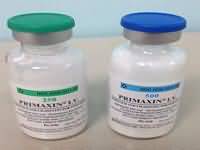CLINICAL USE
Antibacterial agent
DOSE IN NORMAL RENAL FUNCTION
IV: 1–4 g daily in 3–4 divided doses (as imipenem)IM, mild-moderate infections: 500–750 mg every 12 hours
PHARMACOKINETICS
DOSE IN RENAL IMPAIRMENT
GFR (mL/MIN)
31–70 500 mg every 6–8 hours21–30 500 mg every 8–12 hours<20 250–500 mg (or 3.5 mg/kg whichever is lower) every 12 hours
DOSE IN PATIENTS UNDERGOING RENAL REPLACEMENT THERAPIES
IMPORTANT DRUG INTERACTIONS
Potentially hazardous interactions with other drugs
ADMINISTRATION
Reconstition
250 mg with 50 mL, 500 mg with 100 mL sodium chloride 0.9% (in some units 500 mg with 50 mL)IM: 2 mL lidocaine 1%
Route
IM, IV peripherally or centrally (500 mg/50 mL – given centrally)
Rate of Administration
250 or 500 mg dose over 20–30 minutes 1 g over 40–60 minutes
Comments
–
OTHER INFORMATION
Risk of adverse neurological effects, e.g. convulsions. Extreme caution required in patients with history of CNS diseaseCilastatin can accumulate in patients with impaired renal functionSodium content 1.72 mmol/500 mg vial Imipenem is administered with cilastatin to prevent metabolism of imipenem within the kidneyNon-renal clearance in acute renal failure is less than in chronic renal failurePatients with GFR<5 mL/min should not receive drug unless HD is started within 48 hours. Metabolised to inactive, nephrotoxic metabolites
